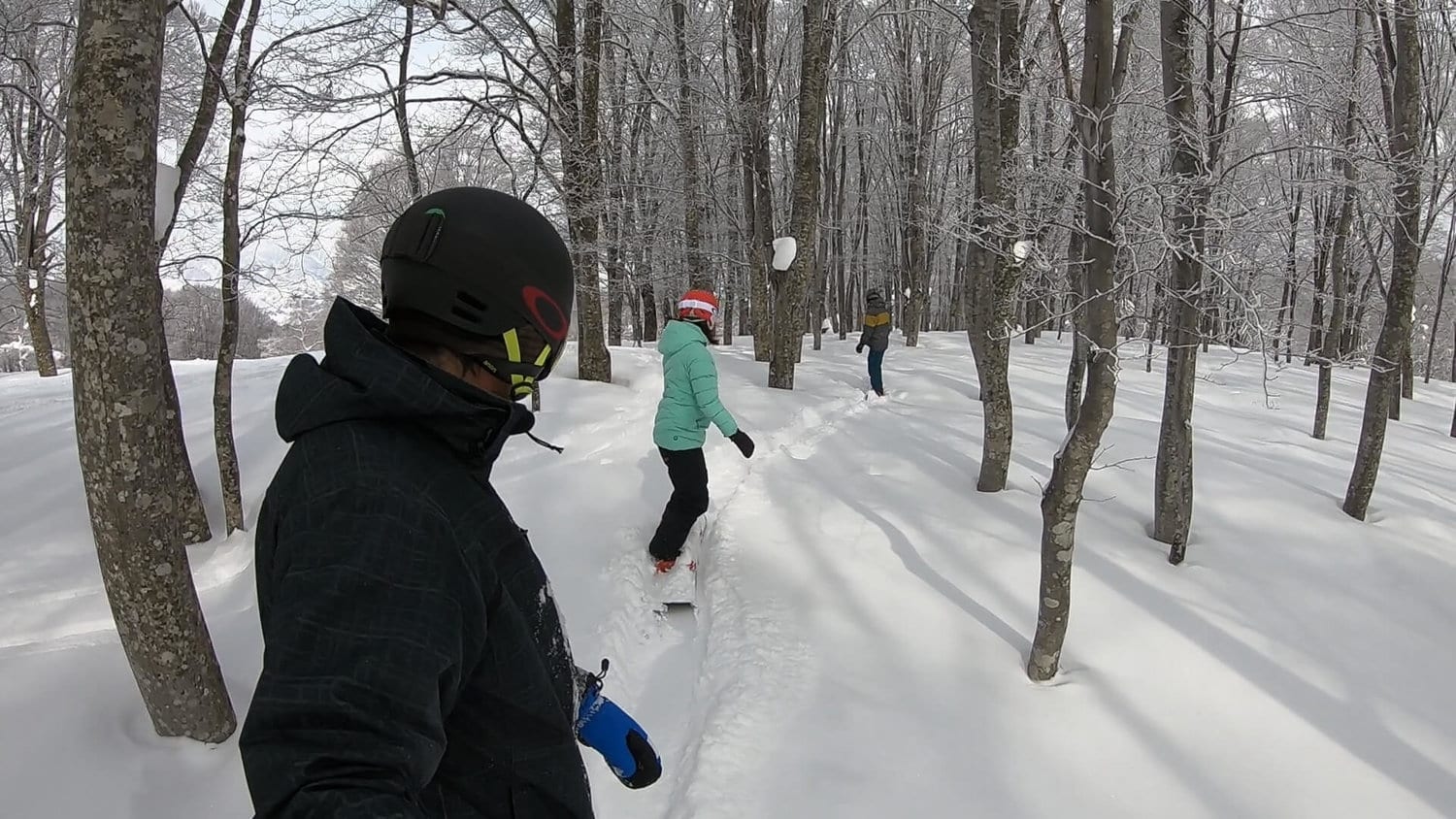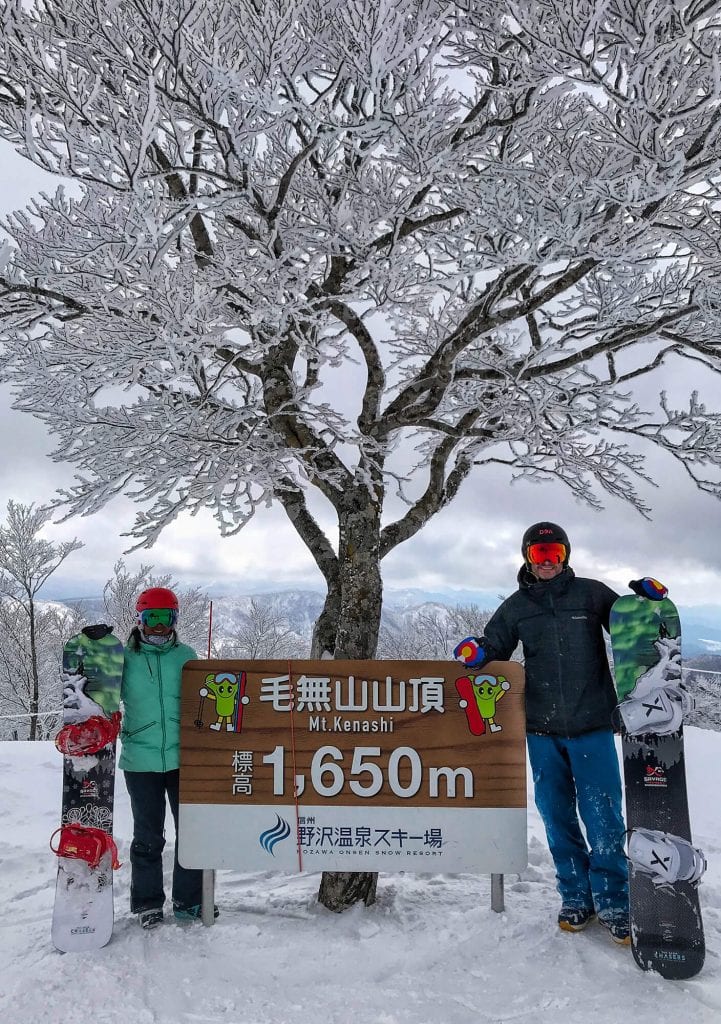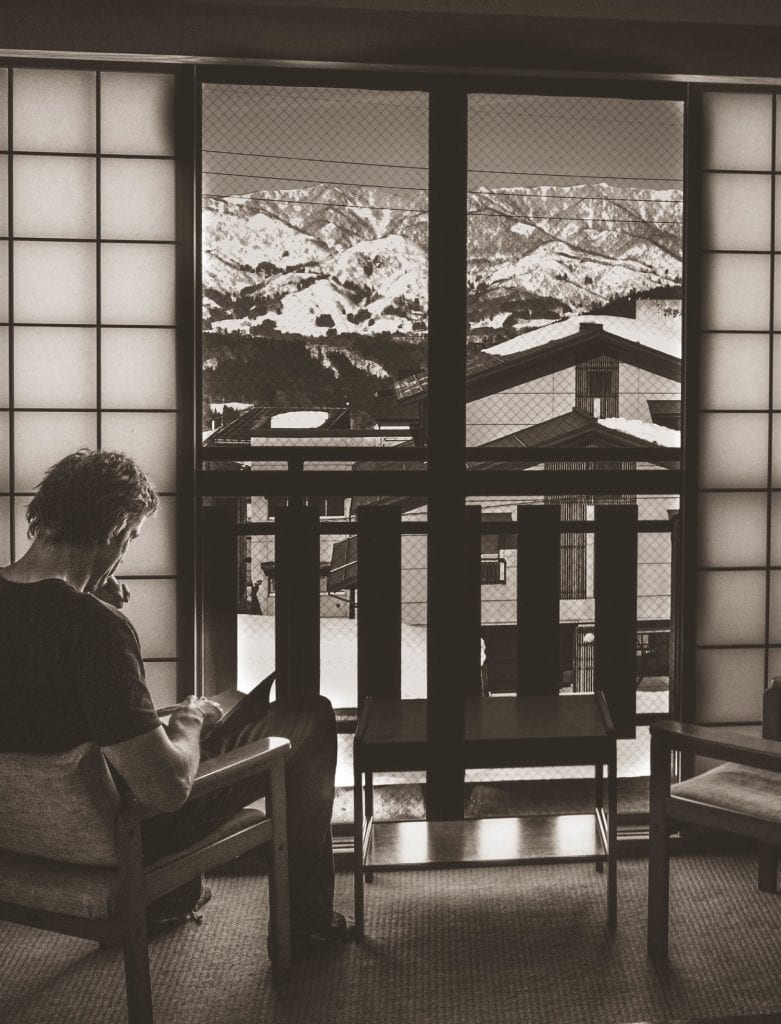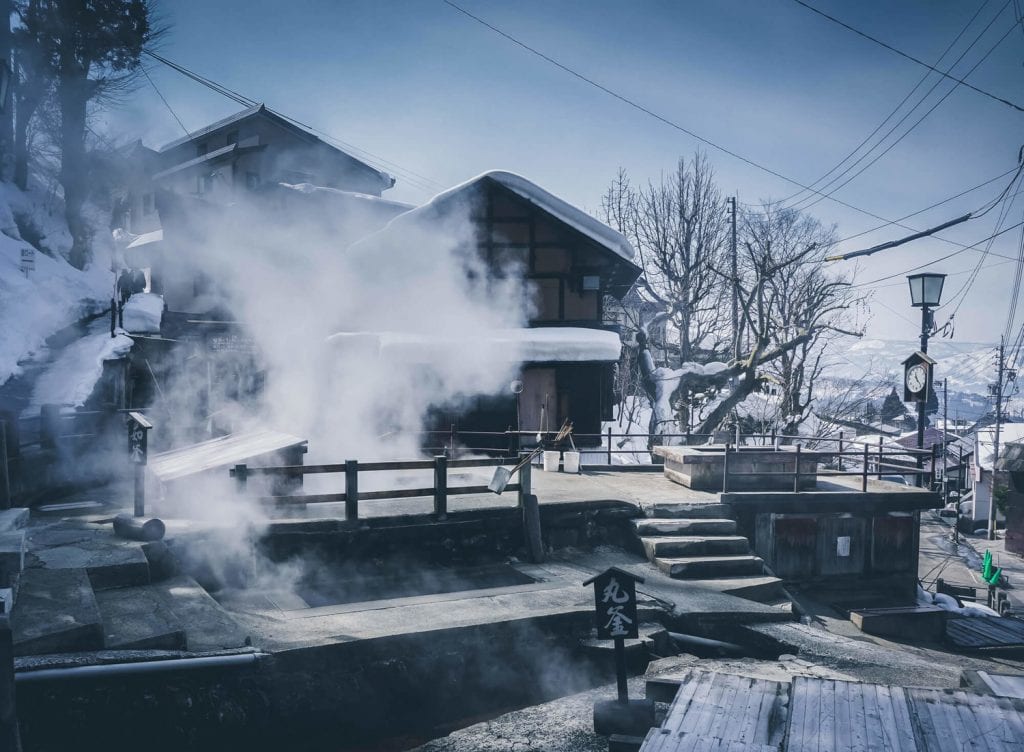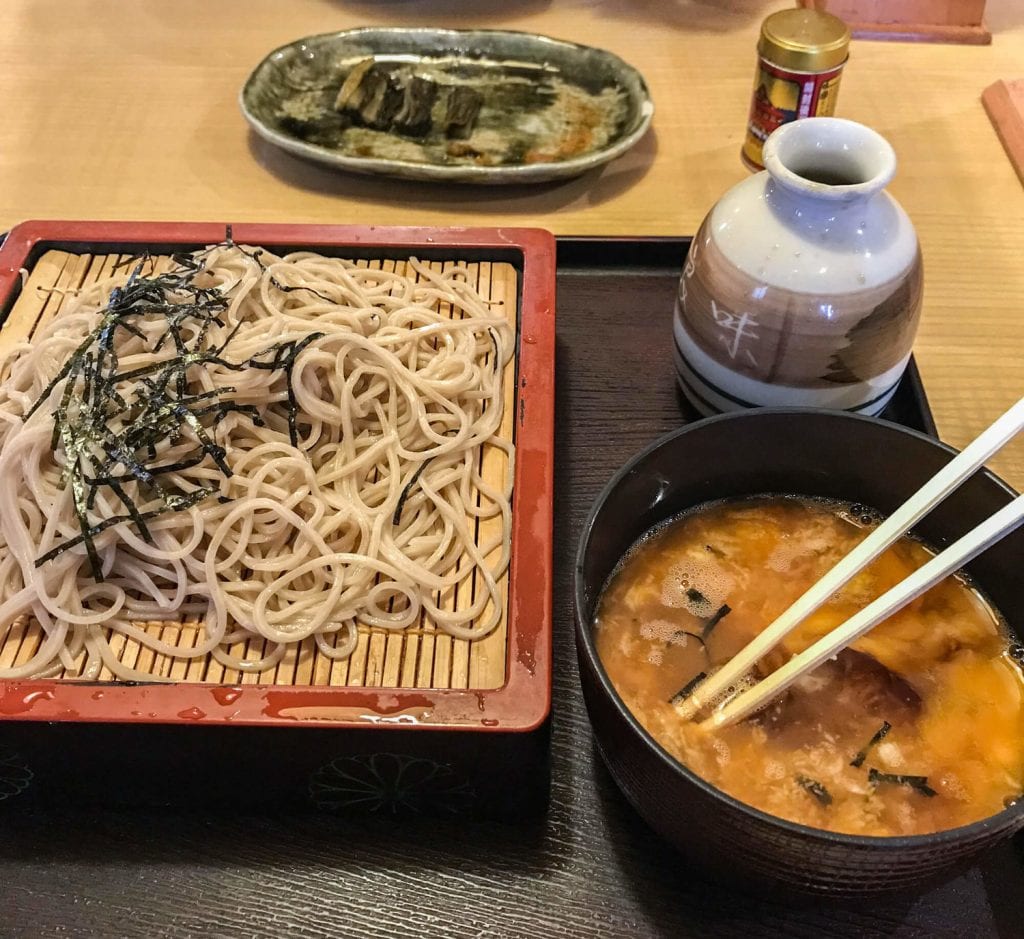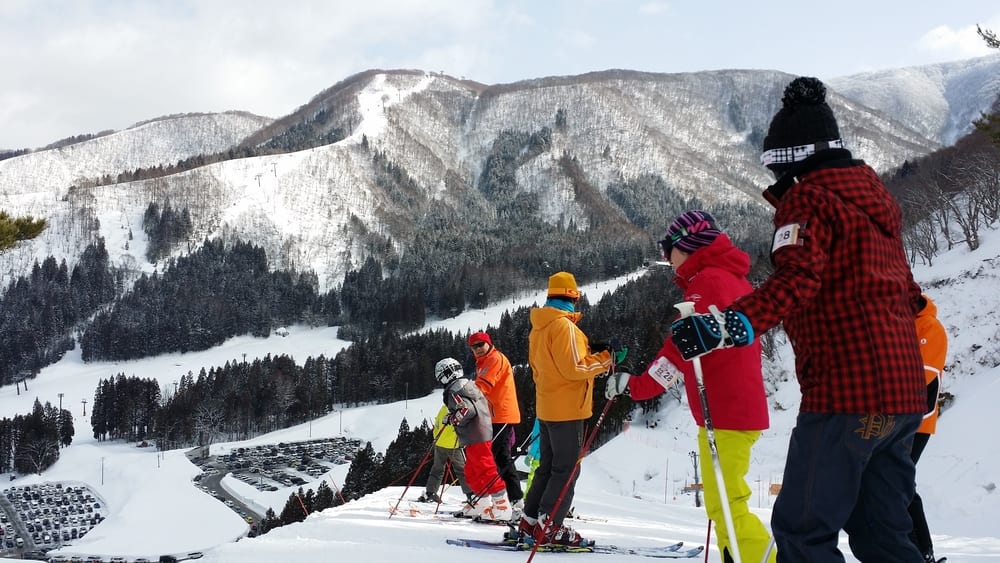Jen and Mick, a.k.a The Snow Chasers, hit up Nozawa Onsen in Japan last season. This is their guide to Japan’s most authentic feudal snow resort town.
The first thing you notice when arriving in Nozawa Onsen is how traditional it feels compared to places like Niseko. This place was a Japanese mountain village first, founded in 924 AD and a snow resort second when it became ‘the birthplace of skiing in Japan’. We found it really refreshing and as a tourist you feel like you’re getting a better taste of traditional Japanese culture.
In terms of size, the resort is 297 hectares and offers 1085 metres of vert. We came chasing the powder, gave ourselves 10 days to enjoy the white fluffy stuff but were graced with unseasonally warm weather for the whole time we were there (late February to early March). Mother Nature, she’s a fickle beast.
We did have quite a bit of fun on the spring slush in the afternoon, and with a two metre plus base, we weren’t worried about hitting any hidden obstacles.
We also scored two powder days. Yes!
Getting there
Catching a bus from Narita airport in Tokyo is easy and about $AUD130 each way. We used Nagano Snow Shuttle and it was hassle free, direct from Narita to our accommodation. It does take a while though – waiting at the airport until departure (our flight arrived 5:00pm and the shuttle didn’t leave until 7:00pm) plus transfer, meant we didn’t arrive in Nozawa until midnight.
If you’d like to experience the Bullet Train, that’s a good option too and takes around 90 mins less and slightly more expensive at around $AUD145 to Iiyama and then a bus from Iiyama to Nozawa Onsen ($AUD7).
Our favourite snowboard/ski runs
Due to the warmer weather, we usually headed to the top of Mt Kenashi and rode the Yamabiko area. Really nice terrain through the trees and a couple of gullies which felt like natural halfpipes. Get there early on a pow day as with all the best terrain on the mountain, it can get chewed up quickly.
We had a super fun day riding the Yunomine & Mizunash chairs on one of the powder days we had. The pair were only running on weekends while we were there but with most of the crowds heading up to the Yamabiko area, we discovered a welcome haven riding here. Not super steep and with the old-school fixed chairs, seemed to keep the crowds away.
If you want speed and distance, head down Skyline into Kamoshika (or Tanuki) onto Karasawa. The top of Skyline is steep and opens up onto the super fun green run of Karasawa – carving heaven and uncrowded so you can get real playful without feeling like you’re going to take someone out. Top to bottom is around 7kms – now that’s a long run!
We would have liked to explore the steeper, ungroomed runs like Schneider, Utopia-A, Ushikubi and Kurokura but the lack of snow during our visit meant these runs were hard and full of moguls. We definitely saw the potential though.
The park and other features are good fun, with nothing too extreme so you feel confident hitting most things. There’s also a half pipe too.
Apart from the powder, we love the lift ticket prices in Japan. How does less than $AUD60 for a full day sound? And talk about flexibility, they offer morning (08:30-13:00) or afternoon (12:30-17:00) passes for around $AUD45.
There are quite a few other snow resorts in Nagano, some easily accessible as day trips from Nozawa Onsen. With more time and better conditions, the ones on our radar were Togari Onsen Ski Resort (20 mins), Madarao Kogen Ski Resort (40 mins), Shiga Kogen (60 mins) and Lotte Arai (65 mins). Further, but still in Nagano, are Hakuba and Cortina but these are over two hours from Nozawa Onsen.
Dining out
It’s not only the powder which keeps us coming back to Japan, it’s the food. Whether on-hill or in the village, you won’t be disappointed with the culinary delights on offer. Great value too, compared to eating on the mountain in Western snow resorts.
We discovered places to eat talking to other guests, the hosts at the accommodation and doing some online research. On-mountain, you could do a lot worse than eating at the base of Hikage gondola. A few places to choose from but our favourite was Uchida Shokudo offering nice big rice or noodle bowls for $AU10-12.
During the snow season, restaurants can get quite busy during the peak 6-9pm eating times. If you’re travelling in a group larger than two, our suggestion is to book in advance.
We found an easy solution – once we finished dinner, we’d walk to where we wanted to eat the next evening, and book. Simple but effective. And a nice way to explore the village, walk off our evening meal and find a place to have a drink.
Restaurants would often serve you complimentary Nozawana (pickled vegetable) as a starter. Nozawana is famous to the area, depicted by the large green inflatable vege at the base of Hikage gondola. They are proud of their Nozawana, so paying a compliment on their version of the vegetable will earning you plenty of kudos.
Many of the restaurants are small and their signage is not prominent. Often it looks like you’re walking into someone’s lounge room – on one or two occasions we had to double check we were actually in a restaurant.
Get the town map at your accommodation which will show the restaurants with a corresponding number. This number is often displayed at the front door making it easier to distinguish.
There are a few little bars and karaoke places scattered around the place but the nightlife won’t compare to places like Niseko. If you want to party hard every night, Nozawa Onsen is probably not the place for you.
We dropped into Tanuki Bar (under their accommodation and restaurant), which is not a locals place but still has a cool vibe none-the-less. Most locals will congregate in karaoke bars once they finish their evening meal.
For a little après, head to Neo bar which overlooks the Olympic ski jump. We grabbed a crepe and a rum hot chocolate as we relived the day on the slopes.
Talking of crepes, we visited a little hole-in-the-wall more than once on our post-meal evening strolls. Amazing, tasty and all for around $AUD5-7. You’ll find it on the main road (38) between the bus terminal and Ikemitsu Shokudo.
A note on language
English is definitely the second language in Nozawa Onsen so be prepared to learn a few rudimentary Japanese phrases and download the Google Translate app. The locals will be beaming if you at least have a go at greeting them in the morning with an “ohayo gozaimasu”, pronounced “oh-high-yoh go-zah-ee-moss”, or thanking them with an “arigatou gozaimasu”.
Most restaurants will either have the food on display or pictures, so pointing and nodding often work. The Japanese are polite and accommodating so you’ll never feel like you’re not welcome. It actually adds to the experience so don’t let the language put you off because it’s not a barrier.
Coffee snobs
Coffee snobs will be satisfied with the availability of Allpress Espresso at St Anton’s, either in the heart of town or at the base of Hikage gondola.
Supermarkets
There is one large-ish supermarket coming into town from the south-west (from Iiyama) along the main road (38). You’ll also find a butcher nearby, also on the 38 but closer to town. Otherwise, you’ll find convenience stores around town which will supply your basic needs.
Money
When I think of Japan, I often think of technology so it’s kinda hard to believe there are only two international ATM’s in town. One is in the post office and one down near the tourist office/bus terminal. The daily limit is 50,000 Yen (approx. $AUD580) and hours are 08:00 to 18:00 (post office) or 20:00 (tourist office).
It’s best to plan ahead and pre-pay stuff like accommodation and use your credit/debit card to pay for lift tickets. Most restaurants are cash only so taking some Yen from home is probably a good idea. For tips on getting the most out of your foreign currency, check out my recommendations here.
Hot springs in Nozawa Onsen
Long before Nozawa Onsen was famous for its snow resort, people came from far and wide for the onsens. Fed by natural hot springs, each onsen is unique and cared for by members of the local community. In Nowaza Onsen, there are 13 soto no yu (public hot spring baths) as well as foot onsens (a must do) that line the cobbled streets (simply roll up your snow pants and put your bare feet in) and many cooking onsens. The town is known to have over 50 public and private onsen offerings all up.
Will I have to get naked? Yes but not to soak your feet or to cook. It may seem a little confronting at first but locals are indifferent to their (and your) nakedness. If you still can’t do it, visit Sparena which is unisex and bathers are worn. Apart from Sparena, which costs $AUD7, the other onsens are free and sex-segregated.
This blog was originally published by Mick and Jen as A Complete Guide to Nozawa Onsen published on The Snow Chasers. If you’d like to read the full unedited version with more info pop over here.


















